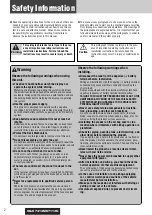
DS-0 (Digital Signal-Level Zero)
Digital Signal-Level Zero is a single 64Kbit channel inside a T1/PRI span.
Extended Super-frame Mode (ESF)
Extended Super-frame Mode consists of 24 frames. The frame bit uses only 6 frames leaving 18 bits for other
purposes. These spare 18 bits provide 6 bits for CRC information and 12 bits for a facility data link. The facility
data link is for maintenance information (as defined by the ANSI T1.403 specification). Like the super-frame
mode, the 64–Kbit user channels have 24 frames available for use. ESF is standard with ISDN–PRI service.
FDL (Facility Data Link)
The Facility Data Link is a 4–Kbit communication link from the network to the T1/PRI board. The system sends
preemptive messages (for example, yellow alarm and loop back), if needed, and sends error packets to the
network once a second. The packets contain alarm history in accordance with the ANSI T1.403 specification.
FDL is standard with ISDN–PRI service.
In band Signalling
A signalling method where the system sends overhead signalling along with channel traffic.
Loop-back Local
An operation method that loops the T1/PRI board’s transmit output and receive input paths. The loop back
terminates all traffic and halts call processing. While in this idle condition, the system continues to transmit the
T1/PRI transmit stream to the network but it will not answer incoming calls. If the remote T1/PRI equipment is
the clock source (primary or secondary) for the DXOPT-SYN card, the remote equipment terminates the reference
signal because the network receive circuit is open in local loop back. You initiate local loop back by setting the
appropriate SW1 switches. The main purpose of local loop back is to verify the T1/PRI board’s ability to
synchronize properly.
Loop-back Payload
The loop back payload feature is an ESF method of loop back which loops the network receive input path to the
remote T1/PRI equipment’s transmit output path. This loop back method does not loop the first bit of each frame
to allow the T1/PRI board’s facility data link to continue to transmit maintenance information. You can use
switches SW2–7 and SW2–8 to manually initiate the payload loop back or you can allow the network to send an
FDL message to initiate or restore the payload loop back. The T1/PRI board goes out-of-service during the loop
back time.
Loop-back Remote
The loop back remote feature loops the network receive input path to the remote T1/PRI equipment’s transmit
output path. The remote loop back feature terminates all traffic and halt any call processing. You can use the
SW2 switches to manually initiate remote loop back or you can allow the network to remotely initiate the
condition. The T1/PRI board’s facility data link, or maintenance channel, can enable and disable remote loop back
automatically or you can set SW2–7 on and SW2–8 off to manually enable remote loop back or set both switches
off to manually disable the feature.
Installing And Programming The DXPRI Card
IMI89–255
Defining The T1/PRI Terms – 37
Содержание DXP Plus Series
Страница 1: ...Digital Communications System R ...
Страница 363: ...Automatic Call Distributor Technical Manual R QuickQ DXP ...
Страница 424: ...Automatic Call Distributor System Manager s Guide R QuickQ DXP ...
Страница 500: ...Wrap up Time 1 6 Wrapping Up A Call 4 3 Z Zoom Box A 2 GCA70 271 Index I 3 ...
Страница 628: ...Interconnecting The VMI X Installing And Programming For ExecuMail IMI89 206 Installing And Programming For ExecuMail 5 ...
Страница 677: ...Connecting The Equipment Installing And Programming The OPX X IMI89 209 Installing The OPX X 7 ...
Страница 728: ...DP I I I I and FX Series Digital Communications Systems Understanding The Visual Man Machine Interface COMDlA ...
Страница 1112: ...9 08 8 90 1 13 4 78 3 94 UNIS029 TAB003 PLS page 6 GCA40 130 DXP Plus General Description 11B Telephone Features ...
















































